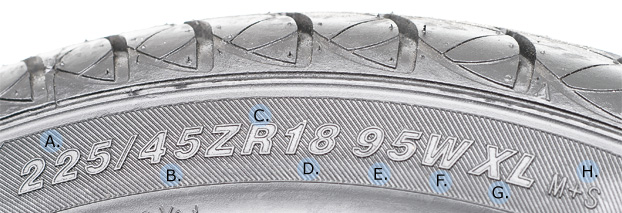
Tire Labelling 101
The Sidewall of your tire is labelled with several specifications that are important for you to understand.
Here is a brief explanation on some of the most common specifications.

A. SECTION WIDTH:
Section width is the width of an inflated tire in inches at its widest point.
B. ASPECT RATIO:
Section width and height are used to determine the Aspect Ratio. The lower the ratio, the shorter the sidewall.
C. RADIAL:
The “R” stands for “radial”construction.
D. RIM SIZE:
The diameter of the wheel (not the tire) in inches.
E. LOAD INDEX:
The load index number corresponds to the maximum load-carrying capacity of the tire. Refer to load index values in the chart to the right.
F. SPEED RATING
The speed rating corresponds to the tire’s maximum speed capability (under optimal conditions).
G. LOAD:
This value refers to the type of load amount a tire is designed to handle. XL stands for Extra Load. The absence of a letter value automatically indicates Standard Load which may or may not be represented by the letters SL.
H. M+S
If shown, M+S stands for “Mud and Snow” indicating that the tire has been designed to perform in these conditions. Note: All winter tires must bear the 3 Peak Mountain Snowflake (3PMS) symbol indicating suitability for winter application.

|
|
|
UTQG Ratings:
UTQG stands for Uniform Tire Quality Grading. This ratings consist of the following 3 components: Traction, Temperature and Treadwear.
TRACTION

Traction grades range from AA, A, B and C (AA being the highest grade). These letters represent a tire’s ability to stop on wet pavement as measure on a specified government test course. Any tire rated below C is considered unacceptable for road use.
TEMPERATURE

The temperature grades range from A, B and C (A being the highest and C the lowest). These letters denote a tire’s ability to dissipate heat under a controlled indoor test environment. A tire rated below C is considered not approved for road use.
TREADWEAR

This is the wear rate of the tire, comparable only to other tires within a tire manufacturer’s line. 100 is the baseline. A tire with a rating of 200 will last twice as long on the government’s course as compared to a tire rating 100.


